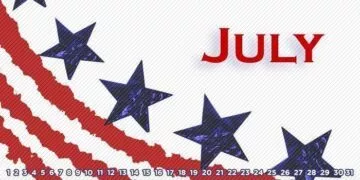Lying between June and August, July is the seventh month of the Gregorian calendar.
As we’re at the beginning of the second half of the year, it’s a great time to start on a new foot.
It’s also a great point to start working on any of those new year’s resolutions that you’ve put off attempting for the first half of the year!
Like all other months, July has a pretty storied history worth taking a closer look at!
So, let’s do just that and look at the origins of the month, the interesting observances it has, and some significant points in history that happened to fall in July!
July was named after the famous Roman general Julius Caesar by the Roman senate; as it was the month he was born in. Julius Caesar was a formidable military general and statesman who was largely responsible for changing the Roman Republic into the Roman Empire. The month was previously called Quintilis (Latin for fifth) as it was the fifth month of the 10-month-long ancient Roman calendar.
As the second month of Summer, July is, on average, the warmest month of the year in the northern hemisphere. Its southern hemisphere equivalent is January.
In the southern hemisphere, though, July is, on average, the coldest month of the year, being the second month of winter.
In early July, a period of time called the “dog days of summer” begins. Historically they were observed within Ancient Roman and Greek astrology and were connected with bad luck, mad dog attacks, unexpected thunderstorms, heat, and drought. They gained their name as “dog days” as they were connected with the star Sirius, which is part of the Canis Major (Greater Dog) star system. Nowadays, “the dog days” refers to when the hottest days of summer begin.
Coincidentally, it was in July that the rabies vaccine was first successfully given to a patient. The French microbiologist Louis Pasteur administered the vaccine to a nine-year-old called Joseph Meister on July 6, 1885. The child had been bitten by a rabid dog, and Louis Pasteur, unsure whether the vaccine would be successful, decided it was worth testing. Fortunately for the boy, it worked!
On July 5, 1946, the world’s first bikini was unveiled in the famous Piscine Molitor swimming pool in Paris. Just in time for the heat of summer, the bikini was modeled by showgirl Micheline Bernardini. While two-piece forms of swimwear previously existed, none used as little fabric as the bikini.
Julius Caesar wasn’t the only military genius born in July. Alexander the Great was another important historical figure who changed the shape of the world and was born somewhere around July 20, 356 BC. Other famous people born in July include Frida Kahlo, Franz Kafka, Marcel Proust, and Nelson Mandela.
The Anglo-Saxons had multiple names for the month of July, including Maed-monath and Hey-monath. Respectively, these translated into “the flowering of meadows” and “hay month.”
On July 4, 1776, the 13 American colonies declared their independence from the British monarchy. The 4th of July, formally known as Independence Day, has been a federal holiday since 1870 in the United States of America.
July isn’t just the month for Independence Day, though. There are plenty of other great holidays observed around the world! July 2nd is World UFO Day, while July 3rd is Stay out of the Sun Day. In the US, July 6th is a pretty delicious day, as it’s National Fried Chicken Day! At the end of the month, we also have International Tiger Day on July 29th.
July has some pretty delicious month-long observances, too! In the US, at least there are three, in particular, that stand out – It’s National Watermelon Month, National Hot Dog Month, and National Ice Cream Month. Yum!
On July 25, 1909, Louis Bleriot became the first man to fly an aircraft from one country to another successfully. He took off from the coast of France and landed across the channel near Dover, England.
There are two star signs which fall in the month of July. If you’re born before July 22nd, then your star sign is Cancer. If you’re born after this day, from July 23rd onward, then you’re a Leo. Those born under the sign of Cancer are said to be loyal friends with great emotional depth, and those born under the sign of Leo are said to be very proud people who display great leadership.
July 12, 1943, was an explosive day. On this day, Russian and German forces fought the largest tank battle in history, with 900 tanks on either side obliterating each other at close range. After a cease-fire was ordered and the smoke cleared, there were only 300 German tanks left standing.
If you’re doing everything right, then crops of corn are meant to be “knee-high by the fourth of July.” It’s also in July that crop circles start to appear in fields of corn. For the most part, Crop circles have only started appearing since the 1970s, although there have been a number of cases sporadically reported throughout history.
Despite it being the first month in the second half of the year, July 1st is not actually the middle of the year. In a regular non-leap year, the midpoint is actually on July 2nd at 1 pm.
July has two birth flowers – the water lily and the larkspur. The water lily is a symbol of a pure heart, while the larkspur (especially its white form) represents the lightness of the heart.
The birthstone of July is the ruby, considered by many to be the king of gems. At one point in time, it was considered to protect warriors on the field of battle if it was embedded in their armor. Nowadays, as a birthstone, it’s said to protect against evil.
July was an important time for the space race of the ’60s. The first crewed mission to the Moon, the Apollo 11 Mission, launched on July 16, 1969. Four days later, on July 20, 1969, Neil Armstrong made history by taking the first step on the Moon while declaring, “That’s one small step for man, one giant leap for mankind!”.
July 16, 1945, was another big day for the world and a step down a very dark period of history. It was on this day in Alamogordo, New Mexico, that the first atomic bomb was detonated. The bomb was called “Fat Boy,” and its explosion sure was fat – the mushroom cloud was 41,000 feet (12.5 kilometers) high!

If you live in the northern hemisphere, then I get why you might not like July.
It’s hot, and it’s uncomfortable, but that’s just how summer is!
Make sure you take a break from the city and get out into the countryside, to a lake, or even better – the sea!
For those of you in the southern hemisphere, you better wrap up nice and warm and enjoy those long evenings inside relaxing by the fire.
Wherever in the world, though, rejoice – the year is halfway over already!


















